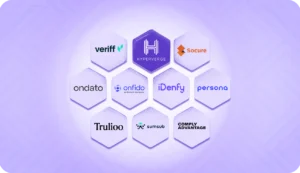In the wake of RBI’s emphasis on video-based customer identification process (V-CIP), the financial services sector is undergoing a revolutionary shift with the adoption of Video KYC. At Hyperverge, we see Video KYC not merely as a technological upgrade, but as a transformative approach that redefines customer verification. This innovative solution offers real-time, safe identity verification, transcending the limitations of traditional KYC methods, and delivers unparalleled convenience and efficiency.
As financial institutions strive to meet the growing demand for seamless digital experiences, Video KYC is emerging as a crucial tool to ensure regulatory compliance while increasing customer satisfaction. This guide explores the profound impact of Video KYC, its benefits, and best practices for implementation.
What is video KYC and why is it important
Video KYC allows businesses to verify customers through a video call. This means that customers don’t have to visit a bank or financial institution in person to confirm their identity. Video KYC plays a crucial role in making the onboarding process easier, enhancing customer experiences, and helping companies meet regulatory requirements efficiently. It’s a win-win for customers and businesses alike!
Difference between video KYC and traditional KYC
While both methods are prominently used to verify individuals’ identity, Let’s understand what the basic differences between them are
| Video KYC | Traditional KYC |
| Customers can verify their identities remotely through a video interface anywhere and at any time. | Customers need to visit the branch in person for identity verification. |
| An individual can submit digital documents. | An individual must provide physical copies of documents. |
| VKYC ensures quick onboarding and high efficiency. | This involves a lot of manual processing and takes up a lot of time. |
| More cost-effective due to automation and digitalized procedures. | Manual processing and resource allocation result in higher costs. |
| VKYC has improved compliance by conducting real-time checks and following regulatory standards closely. | Compliance achieved through manual verification is potentially less robust. |
| Utilizes advanced technologies like AI, biometrics, and end-to-end encryption for verification. | Manual verification processes are not integrated with advanced technology in this system. |
Video KYC use cases
Video KYC is emerging as a transformative solution for various industries in India, particularly in the financial sector, due to its ability to streamline customer onboarding processes while ensuring compliance with regulatory standards.
Here are some key use cases of Video KYC:
- Banking, financial services, and fintechs: Major banks and financial institutions are at the forefront of implementing Video KYC to enhance customer onboarding and compliance.
- Insurance: Insurance companies are using Video KYC to verify customer identities quickly and efficiently, which is essential for policy issuance and claims processing.
- E-commerce and payment gateways: E-commerce platforms and payment gateways are leveraging Video KYC for merchant onboarding. This accelerates the process, enabling businesses to start accepting payments within hours rather than days.
- Logistics and delivery services: Companies in the logistics sector, such as Swiggy (a HyperVerge customer), utilize Video KYC for onboarding contract staff like delivery personnel. This allows for rapid verification and hiring.
Benefits of video KYC
Video KYC can benefit businesses and customers in several ways, including:
Improved customer experience and convenience
Video KYC provides a frictionless and hassle-free experience to customers. They can verify from anywhere and at any time. Moreover, they do not need to visit the branch or submit physical documents. This certainly has benefits in improving customer satisfaction and increasing retention rates.
Higher efficiency and lower costs
Digitization of KYC helps reduce the time and resources spent on customer verification by any financial institution. Automating identity checks and verification speeds up the onboarding process, hence cutting costs while improving operational efficiency.
Improved compliance and risk mitigation
Video KYC helps banks meet compliance standards set by the Reserve Bank of India (RBI). It puts much emphasis on strong cybersecurity, requiring periodic infrastructure up-gradation, and ensures connections only from IP addresses located in India. VKYC protects customer data using end-to-end encryption and geo-tags all customer interactions for added security. Banks follow these guidelines to avoid fraud risk and enhance safety in general.
Overcoming challenges regarding video KYC
Here are some of the challenges that V-KYC faces and strategies for overcoming them:
Limited network bandwidth in remote towns
Remote towns and rural areas are generally plagued with poor internet connectivity. This has to be made better for seamless video calling. Implementing some appropriate adaptive streaming technologies that enable automatic adjustment of video quality based on the available bandwidth can help and one can also partner with an available telecom provider in the area for better coverage.
Lack of awareness among customers
Some consumers need to be made aware of the video KYC process and they may need to be made aware of the advantages of such processes. Social media, email, and in-branch efforts should assist in putting out awareness campaigns. It’s essential to provide clear step-by-step guides and tutorials that customers can easily access to learn the process.
Customers reluctant to video calls
A few customers are hesitant to use video calls to verify identity. So to ease the process for them, make it secure and user-friendly with robust privacy measures and also address any fears of inconvenience and risks by providing alternatives for those who are more skeptical or by guiding them through the process.
How does Video KYC work
The Video KYC process is designed to ensure a secure and efficient way of verifying customer identities. Here is a step-by-step guide to the process:
1. Initiate video calling: A customer can initiate a video call with a KYC officer through a sent link.
2. Interview through video KYC: The officer will verify the identity of the customer in a suitable period with standard questions through video KYC procedure and by holding up his proof of identity in some manner.
3. Face matching and liveness: AI matches the customer’s face with the ID and performs the different levels of checks for the liveness of the person while ensuring that he is present there and not a photograph.
4. Document verification: Capturing and verifying documents of the surveyed customer on a real-time basis.
5. Completion and confirmation: Once the verification is completed, a notification goes to the customer. The process will continue for validation, and this will be used for logging compliance processes as well.
6. Face verification and liveness detection: An individual needs to be alive and physically present, not just a photo or video. This is done to prevent spoofing of the information and to preserve the integrity of the KYC process.
Regulatory Requirements for Video KYC
The RBI lays down detailed regulations for V-CIP. V-CIP is a specific implementation of Video KYC (vKYC), where vKYC refers to the process of verifying a customer’s identity through video interactions. Recent trends have seen the traditional KYC process being streamlined and digitized through Video KYC, making it more efficient and customer-friendly. Some of the key stipulations to this are as follows:
- Infrastructure compliance: A Regulated Entity (RE) must ensure that its V-CIP technology infrastructure complies with RBI guidelines on Cybersecurity and Resilience. The technology must be hosted on their premises and ensure secure network connections. They securely store video recordings and customer data in India with proper date and time stamps for easy retrieval. Ensure that no third-party providers keep any data, especially in cloud deployments; the REs are accountable for this.
- End-to-end encryption: Encrypt the VCIP process data in motion to protect customer information. Provide verifiable customer consent registration.
- Geo-tagging and identification: Include geotagging (live GPS coordinates) in video recordings and ensure quality is good enough to identify customers. Use facial recognition technology to combat identity fraud.
- Monitoring and compliance: Conduct a parallel audit for each account opened through the V-CIP channel to verify the process. The REs also keep a detailed log of the V-CIP sessions, including the credentials of the officials concerned.
Industry-specific requirements for video KYC
Different industries modify video KYC requirements for their specific operational needs:
- Banking sector: Banks should have strict measures concerning customer authentication. They quite frequently use V-CIP during the onboarding of individual customers, proprietorships, and legal entities.
- Fintech companies: They use V-CIP to onboard customers faster and comply with regulatory standards. Fintech companies efficiently and safely carry out V-CIP processes, usually by integrating advanced technologies like AI in identity verification.
- Insurance companies: They leverage V-CIP to authenticate the identity of their policyholders while they make the application. They adhere to specific provisions regarding CDD and ensure to document and retain every customer interaction.
Each industry adapts to the general V-CIP rules. They must make customer identification effective and secure. The rules must fit with the industry’s compliance requirements.
Check out our blog for details on the RBI guidelines for V-CIP.
Data privacy and consent considerations
Manage consent to ensure customers explicitly agree to the use of their data in the Video KYC process. Enterprises should have concrete consent management systems to trace and record all consents.
Adhere to data privacy laws to protect customer information. Ensure that all data handling practices are transparent and secure.
Best practices for video KYC
Implementing effective video KYC requires a blend of advanced technology and customer-centric processes. Here are some best practices to ensure a smooth and secure video KYC experience:
Clear communication
Provide clear instructions and continuous support to the customers throughout the video KYC process. Clear communication enhances user experience and reduces confusion.
Robust security measures
Employ strict authentication and encryption to protect the customers’ data. Artificial intelligence and machine learning can further increase security by the real-time detection of anomalies and possible fraud.
Continuous training
Train KYC officers continuously on new technologies and processes. Such frequent updates ensure that the team is well-versed and better positioned to handle new challenges while maintaining compliance.
Seamless onboarding experience
Design an end-to-end frictionless onboarding workflow. Technology allows for flexible access, where most customers get hassle-free onboarding while high-risk cases are raised for further review.
Comprehensive identity verification
Utilize AI-driven facial recognition and liveness detection to ensure the accurate verification of customer identity. This not only prevents fraud but also makes the verification process quicker and more effective.
Transparency and compliance
Ensure transparency in your verification algorithms and maintain compliance with regulatory standards. This could be ensured by having periodic audits and refreshers of your KYC processes to help them stay updated with the evolving character of regulatory requirements.
Customer-centric approach
Ensure customer experience and trust is at the forefront. Make the KYC process less daunting at the end-user level by simplifying it with user-friendly interfaces and displaying multiple channels of communication for support.
Implementing video KYC
While selecting a video-based KYC solution, there are a number of factors that one should consider to ensure that the chosen technology aligns with the needs of the organization and the regulations that bind it. Below are some important criteria to guide your selection process:
Choose the right video-based KYC vendor
When selecting a video-based KYC vendor, one needs to prioritize stability, security, and the requirements of regulatory compliance. The vendor should provide easy system integration and leverage advanced technologies such as AI for identity verification and fraud detection. Assess customer support, training resources, and scalability in line with business needs. Look for features like real-time monitoring and customized workflows as features that bring in efficiency. Check the credibility of the vendor from client testimonials and industry ratings. Lastly, consider the overall cost-effectiveness to ensure the solution provides value without compromising quality.
Compliance with regulators
Ensuring compliance with all relevant regulators and regulations is crucial to avoid legal complications. A video KYC solution complies both locally and internationally with AML and KYC standards while adapting to changes in regulatory landscapes. HyperVerge’s solution fares well in this regard in that it uses advanced data encryption while following global standards such as GDPR and CCPA. It continuously updates its compliance framework to incorporate new regulations and best practices. Additionally, HyperVerge offers real-time monitoring and extensive audit trails, providing transparent and accountable processes that satisfy regulatory scrutiny
Integrate with existing systems and workflows
Incorporating Video KYC into current systems and workflows to boost productivity and adherence to rules seamlessly. This integration simplifies day-to-day tasks, getting rid of hold-ups while making sure one meets all the rules. By adding Video KYC, one can strengthen workflows and improve customer experience without messing up the current protocols.
Conclusion
Video KYC is an efficient process that has numerous benefits, but it also presents certain challenges that need to be addressed for successful accomplishment. It is important to incorporate V-KYC with additional verification techniques for certain businesses to construct a truly resilient identity verification process.
HyperVerge’s solution excels by leveraging advanced AI for high-accuracy identity verification, liveness monitoring, and robust data encryption to safeguard customer information. Our platform ensures compliance with global standards like the General Data Protection Regulation (GDPR) and Central Consumer Protection Authority (CCPA), to meet highly evolving regulations. These features streamline the KYC process, enhance fraud detection, and boost operational efficiency.
Visit our Video KYC page or get a demo to see how HyperVerge can transform your KYC process, ensuring compliance and an exceptional customer experience.





















